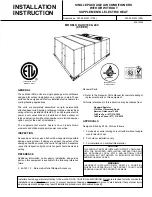
37
ENGLISH
Performing leak test & insulation
Leak test
LEAK TEST WITH NITROGEN (before opening valves)
In order to detect basic refrigerant leaks, the refrigerant pipes and system must
be pressurized with nitrogen (using a pressure regulator) at a pressure above
4.1 MPa (595 psig ). This should be done before connecting a vacuum pump or
releasing the factory R-410A charge.
LEAK TEST WITH R-410A (after opening valves)
Before opening valves, release all the nitrogen from the system. Create a vacuum
with a vacuum pump. Open factory service valves. After opening valves check
leaks using a R-410A leak detector.
•
Discharge all the nitrogen, create a vacuum, and charge the system.
CAUTION
Insulation
Once you have checked that there are no leaks in the system, you can insulate the piping and hose.
1. To avoid condensation problems, place
T13.0 (1/2”) or thicker
Acrylonitrile Butadien Rubber
separately around each refrigerant pipe.
No gap
NBR [T13.0 (1/2”) or thicker]
Insulation cover
Indoor unit
Be sure to overlap
the insulation
Insulation
•
Must fit tightly against
body without any gap.
CAUTION
•
Always make the pipe seams face upward.
NOTE
2. Wind insulating tape around the pipes and drain hose. Avoid compressing
the insulation too much.
3. Finish wrapping insulating tape around the rest of the pipes leading to
the outdoor unit.
4. The pipes and electrical cables connecting the indoor unit with the
outdoor unit must be fixed to the wall with suitable ducts and/or
fasteners per national and local regulation.
•
All refrigerant connections must be accessible in order to permit either unit maintenance or removing
it completely.
CAUTION
Содержание 018 Series
Страница 1: ......
















































